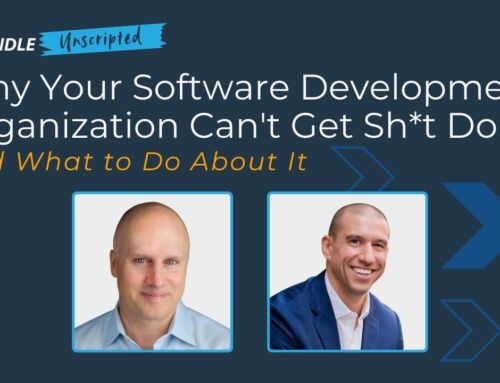Things are moving fast these days. Lightning fast. AI, generative AI, and the rapid evolution of SaaS software are transforming multiple market sectors. It’s been barely a year since ChatGPT was made available to the public, but generative AI tools — many built on top of the ChatGPT platform — are already valued at $67 billion. Bloomberg’s analysts forecast a market value of $1.3 trillion by 2032.
And that’s just one area of tech that is evolving.
For companies and developers, it can be a challenge to keep up with all of the emerging tech trends while ensuring software resilience and stability.
Here are strategies you can use to mitigate your risks and improve the quality of your software.
Building a Product Strategy to Ensure Software Resilience and Stability
Besides emerging tech impacting product development, companies today are working on accelerated development schedules. Speed-to-market is often a deciding factor in customer adoption amid significant competition. Ensuring code quality, moving products through QA and UAT, and constant iteration are crucial. Even small mistakes or errors can create substantial risk.
Yet, the development team is often scrutinized by others in the organization who don’t understand why the team can’t just get the job done. Business leaders may also be questioning if the right product is even being built as product teams struggle to define products and communicate their vision.
Effectively managing a software development team requires a steady hand, navigating the needs and concerns of the various stakeholders and mitigating risk in product strategy.
Risk Assessment in Product Strategy
Surprisingly, many companies overlook the importance of conducting thorough risk assessments during product planning. They may do extensive consumer or customer research to determine product fit, but often don’t take the time to fully understand the risk.
Conducting a thorough risk assessment during product planning involves several key steps:
- Identify risks: Brainstorm potential risks across areas like technology, operations, security and compliance regulations, market competition, and user adoption.
- Analyze risks: Assess the likelihood of each risk occurring and the potential impact.
- Prioritize risks: Rank risks based on analysis to focus on mitigating the most serious threats first.
- Mitigate risks: Develop strategies to reduce likelihood and impact, such as limiting scope, prototyping, pivoting features, or targeting less risky segments first.
- Monitor and re-assess: Risk assessment is not a one-and-done process. Continuously monitoring and mitigating risk through the product lifecycle is critical to making informed decisions — especially in CI/CD processes where development and integration are constant.
- Document risks: Keep a risk register to document identified risks, analysis, priority, mitigation tactics, and ownership.
A formal risk matrix can help you streamline the process and prioritize areas of focus.
Risk Management for Long-Term Software Development Success
To build software that remains relevant and succeeds long-term, teams must adopt flexible architecture and modular design principles. This creates a more agile approach, allowing you to swap out tech components when required without having to do major rework. Another key is to isolate risk by using microservices, APIs, SDKs, or abstraction layers to separate high-risk components.
Rather than hard-coding databases, developers can segregate domains and flow to reduce the blast radius in case of problems or outdated technology. In the same way network administrators want to segment networks to prevent lateral movement by hackers, you want to limit the damage any one component change can inflict on the remaining code base.
Other strategies to manage risk for long-term success include:
- Leveraging continuous integration and delivery: Frequently merging code and releasing smaller updates, it’s easier to incrementally improve quality and prevent big integrations that are risky.
- Assigning risk ownership: Having clear lines of reporting for who is responsible for monitoring and mitigating particular risks.
- Conducting ongoing training: Keeping teams trained on emerging tools and tech, including formal upskilling and reskilling where necessary.
- Prioritizing quality: Despite the demand for speed, do not compromise on best practices, testing, and code quality.
- Monitoring transitive dependencies: The code used by packages that directly integrate with your software can multiply quickly. One study found that 95% of vulnerabilities are attributable to transitive dependencies in open-source code.
Future Proofing Software Projects
In an era of constant evolution, product development teams must emphasize a futureproofing strategy right from the initial design stage.
Planning for sustainability from the start considers the maintainability, extensibility, and ability to upgrade systems over time to stay current and add new functionality. Flexible and modular design, using open standards, provides maximum options for the integration of new components. Developers should also assume the need for horizontal scalability upfront to accommodate significant growth. Cloud infrastructure and distributed systems make this much easier than in the past.
It’s also important to have the right environments for software teams to work in. While there are various environments available to create, teams need a robust workflow that allows for continuous development and improvement and also a positive environment that fosters innovation. This environment must accommodate manual and automated testing to ensure that any changes will not break existing functionality.
While it’s impossible to envision every scenario where tech can and will evolve, teams need to build with the understanding that evolution is imminent. This mindset helps build better code by expecting modifications over time. As such, complete documentation is crucial. As team members come and go, there has to be a record of code builds to maintain continuity.
Development teams also need to stay on top of emerging technology and skills to guarantee software resilience. As new technology becomes available — and customer demands change — dev teams need to have a handle on them to implement them.
Working With an Experienced Development Partner
Working with experienced software development partners can provide invaluable expertise to significantly reduce risk. They will have specialists in particular aspects of product and code development with access to the latest tools and technology.
When you are looking for a development partner, you want to examine not just the products they have built, but how they have done so. Look for a company that prides itself on agile development strategies, iterative testing, and continuous improvement.
It’s a delicate balance between speed and quality, so probe to find out how they walk this fine line. There are trade-offs in every project. You want a company that understands this and takes risk management seriously. The best partners will assess and manage risk at each stage, take proactive steps to mitigate risks, and build a future-proof strategy to ensure software resilience.
Schedule a call with our team to learn more about a product strategy-supported development process today.







